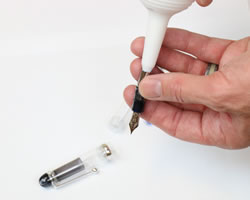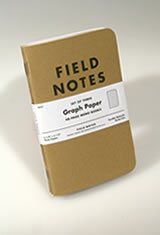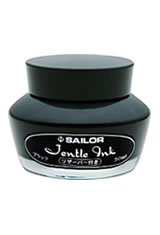How to Fix a Dry Fountain Pen
Fix a Dry Fountain Pen
Occasionally fountain pens write dry or scratchy due to poor ink flow. Here are a few tips or steps on fixing this problem so your pen writes like it should.So how do I fill a converter style fountain pen with ink?

Tip 1
Flush the Fountain Pen
Whether is is a new or used pen it may be writing dry due to a clogged or partially clogged feed system. New pens can come with sediment in the pen while the ink in used pens can dry over time clogging the feed system(it is best to clean out fountain pens when they are not being used). Whether you have an old or a brand new fountain pen the first step is to flush the feed with warm water. This will vary slightly with the type of pen, whether you are cleaning a cartridge/converter fountain pen or cleaning a piston style fountain pen. Running warm water through the pen will flush any small particles or dried ink from the system. You may even try a pen flush to further clean the pen.
Whether is is a new or used pen it may be writing dry due to a clogged or partially clogged feed system. New pens can come with sediment in the pen while the ink in used pens can dry over time clogging the feed system(it is best to clean out fountain pens when they are not being used). Whether you have an old or a brand new fountain pen the first step is to flush the feed with warm water. This will vary slightly with the type of pen, whether you are cleaning a cartridge/converter fountain pen or cleaning a piston style fountain pen. Running warm water through the pen will flush any small particles or dried ink from the system. You may even try a pen flush to further clean the pen.

Tip 2
Prime the fountain pen
With a cartridge converter style fountain pen you can prime the ink. If you are using a cartridge simply unscrew the grip section and then compress the cartridge forcing ink through the feed. With a converter twist the converter a bit until ink appears.
With a cartridge converter style fountain pen you can prime the ink. If you are using a cartridge simply unscrew the grip section and then compress the cartridge forcing ink through the feed. With a converter twist the converter a bit until ink appears.
Tip 3
Consider the Paper
Some papers accept ink better than others. Some paper will absorb too much ink creating bleeding and feathering while other papers will not absorb ink very well at all. Inks that absorb more ink will create thicker lines than paper that does not absorb ink. Some paper is considered fountain pen friendly while others are not. Consider using one of the Memo books we offer with fountain pen friendly brands such as Rhodia or Field Notes
Some papers accept ink better than others. Some paper will absorb too much ink creating bleeding and feathering while other papers will not absorb ink very well at all. Inks that absorb more ink will create thicker lines than paper that does not absorb ink. Some paper is considered fountain pen friendly while others are not. Consider using one of the Memo books we offer with fountain pen friendly brands such as Rhodia or Field Notes
Tip 4
Consider the Ink
Ink flow will vary by the type of fountain pen ink. Some inks such as the Sailor Jentle Inks are self lubricating. Other inks contain particles that may clog the feed system of your fountain pen making the pen write poorly. For a more information on inks see our guide to waterproof fountain pen inks.
Ink flow will vary by the type of fountain pen ink. Some inks such as the Sailor Jentle Inks are self lubricating. Other inks contain particles that may clog the feed system of your fountain pen making the pen write poorly. For a more information on inks see our guide to waterproof fountain pen inks.

Tip 5
Repair
If you have tried each of the above steps and your fountain pen continues to have problems you may need to send it back for repair or consider a nibmeister. Nibmeisters can adjust the nib of the fountain pen so that it writes wetter.
If you have tried each of the above steps and your fountain pen continues to have problems you may need to send it back for repair or consider a nibmeister. Nibmeisters can adjust the nib of the fountain pen so that it writes wetter.
Tip 6
Before the Purchase
Not all fountain pen nibs are the same. For instance, Japanese pens run finer than European or Western manufacturers. The finer the nib the less ink it will use and the finer the line. Finer nibs tend to be scratchier than wider nibs since there is less ink to lubricate when writing. If you want a wetter writer consider selecting wider nibs.






